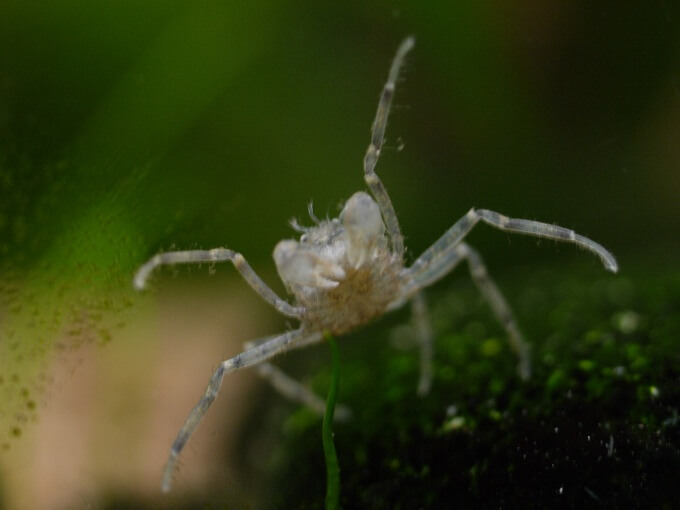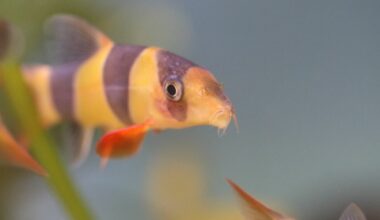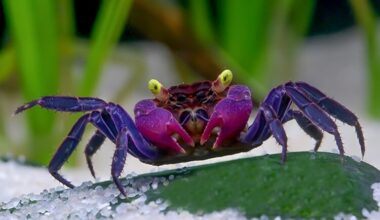The Thai Micro Crab is one of our favorite aquatic critters of all time! They’re fairly under the radar, but we recommend them to other aquarists all the time.
Here’s why:
This is one of the most low-maintenance crab species you can own. They can thrive in a wide range of conditions that most aquarists are familiar with.
They also look really neat! These tiny creatures are quite different from most of the species you see other aquarists own. They look like they’re from another planet!
This guide will teach you everything you need to know about Thai Micro Crab care, and the species in general. We promise you’ll be considering getting some by the time you’re done reading!
Table of Contents
Species Summary
Perfect for nano tanks and small habitats, the Thai Micro Crab (Limnopilos naiyanetri) truly lives up to its name. These crustaceans are some of the smallest that you can get! They’re very docile and can be a joy to watch as they scavenge for food.
These freshwater crabs can only be found in one place in the world. They’re endemic to a specific river in Thailand, hence their name. Sometimes, the Thai Micro Crab is referred to as the Thai Micro Spider Crab or False Spider Crab.
The tiny critters are relatively new to the aquarist community, having been introduced to the market in 2008. However, that hasn’t stopped fish-keepers from purchasing them in droves! There are still many things unknown about this species. Luckily, basic care requirements have long been established.
Lifespan
The normal Thai Micro Crab lifespan is around one and a half years when healthy. These little creatures don’t live very long at all.
It’s worth pointing out that this average is for crabs being kept in a well-maintained environment. Don’t get this species thinking you can exceed this by giving them great care.
Author Note: Because these creatures are so small, they are highly susceptible to changes in the water conditions. To keep them healthy and maximize their lifespan, you must be vigilant about maintaining your tank.
Appearance
If you’re lucky enough to get a close-up view of the Thai Micro Crab, you might be surprised to find that they are very similar to their larger counterparts. They have a circular carapace, which is the main body of the crab.

Typically, these crabs are silvery-gray in color. The legs might take on a warmer brown tone. You may also see some slight transparency in their legs.
These crabs are often mistakenly referred to as spider crabs, and it’s not hard to see why.
Their 10 legs are very long compared to the rest of the body. When fully splayed, their size increases significantly.
However, most of their time is spent with the legs tucked under the body. One interesting thing about Thai Micro Crabs is the filaments growing from their legs and claws.
These hairs are meant to capture food particles in the water. They can grab onto microscopic snacks, which helps tremendously when they’re scavenging for food.
For the most part, there isn’t a size difference between males and females. Though, you can easily identify females thanks to their rounded bodies. Males tend to have narrow and somewhat-pointy carapaces.
Average Size
The average size of a Thai Micro Crab is only 0.4 inches! This is the diameter of their carapace, which is how you measure the size of crabs.
As you can tell, these critters are quite small. However. the size of their legs can make them appear a bit bigger.
Despite this, it can still be hard to locate them in your tank at first (you’ll get better with practice). You see, the thin and semi-transparent nature of the legs doesn’t actually do much to improve visibility.
Thai Micro Crab Care
Thai Micro Crab care is a piece of cake. One of the biggest reasons why this species has become so popular is that they can thrive in very normal and low-maintenance tank conditions.
They’re not like other crab species that may require fine-tuned temperatures or brackish water.
Thai Micro Crabs can adapt very well and aren’t picky about parameters. Of course, these creatures are susceptible to major changes in water quality. The key is to keep their tanks stable while providing them with a high-quality source of food.
Below are the fundamental care guidelines you need to follow:
Tank Size
Starting off with the tank itself, these crabs don’t need a ton of space. At less than half an inch in size, you can keep a group in a relatively small tank.
These crabs are great for nano tanks that can hold at least 5 gallons. A small group of five or six crabs will have no problem thriving in a tank that small.
However, Thai Micro Crabs will need a slightly bigger tank if you plan on keeping them with fish (more on that in a bit).
Author Note: One nice thing about this species is that they’re fully aquatic. There’s no need to worry about creating a chunk of land. They will spend their entire lives underneath the surface of the water.
Water Parameters
As with any aquatic creature, the best way to keep these crabs healthy is to replicate their natural environment as much as possible. This all starts with the water. Luckily, that’s not hard to do.
These crabs come from a single river in Thailand. The tropical environment is relatively easy to replicate in a freshwater tank. All you need is warmer waters and neutral pH balance.
Once you have established the tank, give it some time to cycle through before adding the crabs. Thai Micro Crabs are sensitive to ammonia and nitrate levels. They can also be affected by chemicals in the water.
Giving the tank some time to mature will ensure that it’s safe and ready for these crabs.
Stick to these water parameters and your Thai Micro Crabs should have no problem staying healthy.
- Water Temperature: 72°F to 82°F (somewhere in the middle of this range is ideal)
- pH Levels: 6.5 to 8.0
- Water Hardness: 6 to 15 dKH
It’s also important to test the water regularly (especially early on). Water changes every couple of weeks is paramount, too.
What To Put In Their Tank
When it comes to decorations, a natural setup is always better.
While you could use plastic tank accessories, Thai Micro Crabs need some real organic matter to stay healthy. These crabs spend most of their day foraging for food, and that has to come from real live plants.
Thick vegetation is important. The river that Thai Micro Crabs come from is very dense. More often than not, the crabs can be found living in the roots of those plants.

Adorn your tank with floating plants. You can try out Java Moss, Duckweed, Water lettuce, and Anubias. Introduce as many plants as possible. Not only are they are a source of food, but the plants will also act as shelter.
You can complement the plants with natural decorative items like driftwood and rocks. Those are great places for types of aquarium algae to accumulate, which Thai Micro Crabs also eat.
To keep the tank cycled and in good shape, you’re going to need a solid filtration system. However, these tiny crabs are very vulnerable to strong currents and suction inlet tubes!
Make sure that you’re utilizing foam covers for the tubes to ensure that your crabs aren’t sucked through the filter.
Common Possible Diseases
Not much is known about diseases that Thai Micro Crabs can suffer from. Currently, there aren’t any ailments that are specific to the disease.
That said, they can suffer from all the safe bacterial and fungal infections that other freshwater crabs experience.
The most common cause of any illness with crabs is actually general body stress. Stress is directly correlated with the quality of the water. As long as you maintain water conditions, you should have no problem keeping the crabs healthy.
Author Note: You may witness what looks like a dead crab at the bottom of the tank. Before you take it out, examine it closely. Chances are, it’s a molted shell.
Thai Micro Crabs molt just like any other crab. They shed their carapace as they get larger, leaving behind a hollow shell. This is perfectly normal and healthy.
Food & Diet
Thai Micro Crabs are natural omnivores. As we mentioned earlier, they will typically scavenge for food throughout the day. Using those hairs on their legs and claws, the crabs capture microorganisms and food particles floating throughout the water.
You might also see the crabs feeding on plant detritus and algae.
While they can get a lot of their daily nutrition through scavenging, you need to provide daily meals, too. A popular choice for aquarists is powdered plant-based shrimp food.
You can also try sinking algae wafers or powdered foods that are small enough for the shrimp to consume.
Some protein is crucial for this species as well. You’ll need to supply some hearty live or frozen food, such as mosquito larvae.
Behavior & Temperament
Thai Micro Crabs are very docile and easygoing. They’re shy by nature and will often spend most of the day hiding among plants and natural decor.
They don’t show any signs of aggression towards other creatures. This includes tank mates of the same species!
As a result, they’re great for peaceful community tanks.
This species is very sporadic when it comes to activity too. Don’t be surprised if you don’t see much movement from your Thai Micro Crabs at random points throughout the day.
These crustaceans have been known to sit motionless for several hours. If you can’t see them at all, they are likely hiding.
Hiding is very normal for these crabs. It’s more common around molting time. When they molt, Thai Micro Crabs are incredibly vulnerable to attack because it takes some time for their new shells to harden.
Tank Mates
There are some special considerations to make when choosing tank mates for the Thai Micro Crab. They do fine with other fish and won’t exhibit any signs of aggression.
But it’s not aggression from the crabs you have to worry about.
These critters are the perfect snacking size for large and medium-sized fish. They will be gobbled up instantly by any fish that’s bigger than they are. As such, they should only be kept with small peaceful species.
Remember, these crabs are virtually defenseless. You should never take risks and house them with larger fish that could eat them.
It’s also important to keep multiple Thai Micro Crabs together. They do very well in groups of five or six. The crabs will feel more confident and usually become a bit more active in the presence of others.
Here are some good tank mates to consider:
- Cherry Shrimp
- Kuhli Loach
- Bloodfin Tetra
- Cherry Barb
- Pygmy Corydoras
- Ember Tetra
- Most Snails
- Harlequin Rasbora
- Neon Tetra
Author Note: A lot of aquarists ask about the ability for Thai Micro Crabs to be kept with Betta fish. The answer isn’t very clear since there are some aquarists who’ve had success with this pairing, and others that haven’t.
Understand that there’s going to be an element of risk if you really want to try this out. Personally, we don’t think it’s worth it.
Thai Micro Crab Breeding
Unfortunately, Thai Micro Crab breeding is quite difficult in captivity even though it has been accomplished before. In fact, many crabs will breed on their own accord.
The problem comes with keeping the baby crabs alive.
Many aquarists will observe their female Thai Micro Crabs carrying and releasing eggs (some even hatch). Unfortunately, babies almost always die before they can get any bigger.
Breeders are continually experimenting to improve mortality rates. Until an established method comes up, we recommend that you avoid trying to breed these crabs.
What Do You Think?
We hope this guide has not only educated you on the fundamentals of Thai Micro Crab care, but encouraged you to give this species a chance too.
We’ve heard from plenty of aquarists who swear they’ll always keep some in their freshwater tanks. These tiny critters really grow on you!
If you want to learn more about this species or just have questions in general, give us a shout. Any new opportunity to talk with a fellow aquarist is always welcome.

